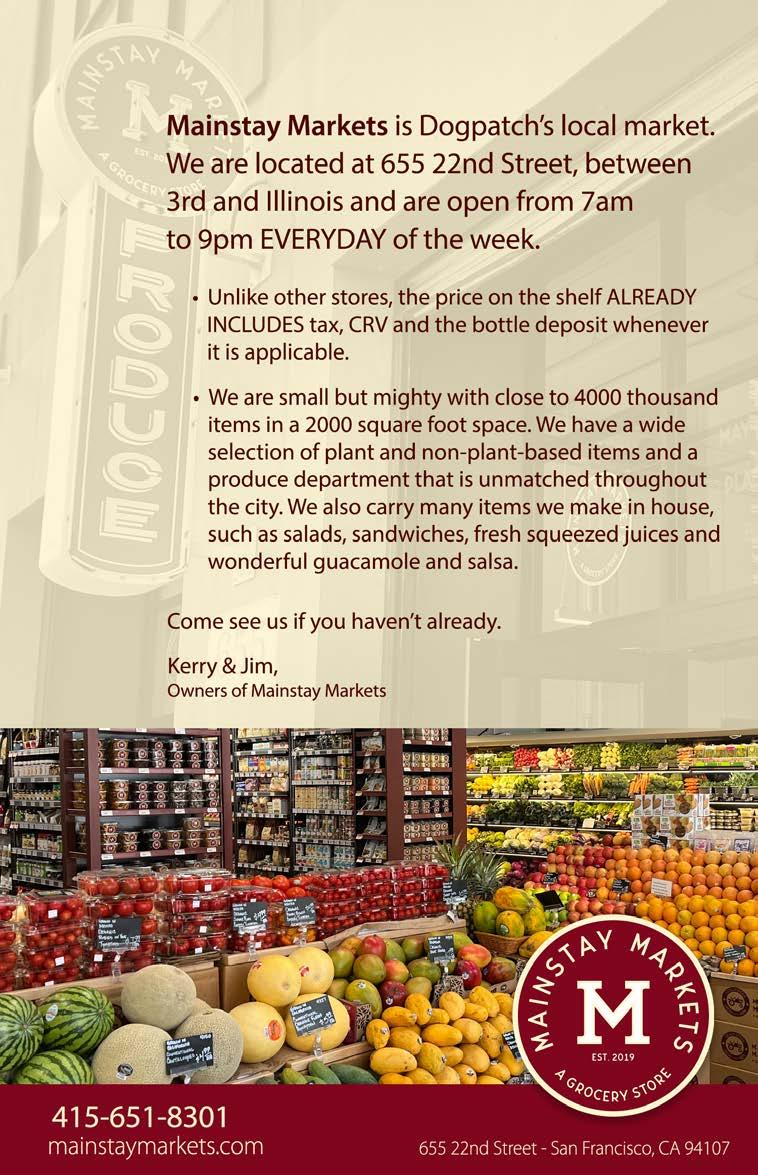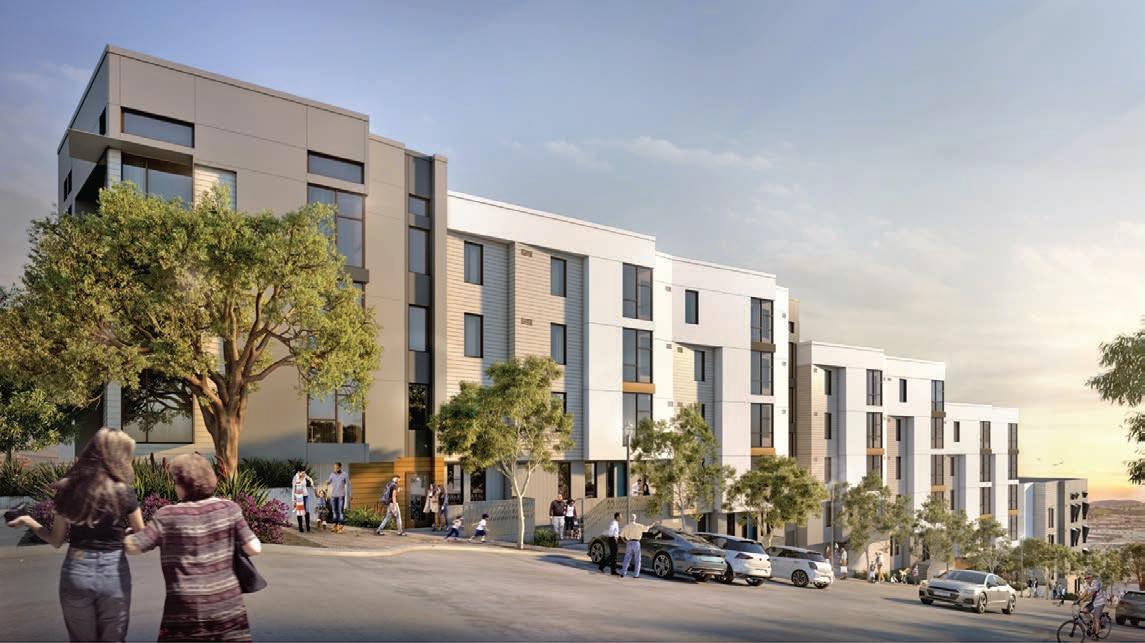
14 minute read
Potrero Annex-Terrace Being Steadily
BY MATT NAMY
The Potrero Annex-Terrace housing community, located on the Hill’s southeast slope, has long been largely isolated from the economically thriving neighborhood to the north. The complex is dominated by barracks-like residences that were built more than 80 years ago. For the past 15 years it’s been part of the HOPE SF redevelopment effort, a partnership between municipal agencies, private real estate developers, and The San Francisco Foundation.
Advertisement
BRIDGE Housing, which operates 21 properties in the City, is leading the effort. Once completed Annex-Terrace ownership and management will be transferred from the San Francisco Housing Authority (SFHA) to BRIDGE, with SFHA leasing the underlying land to Bridge.
Under HOPE SF Annex-Terrace is being demolished and rebuilt in five phases, scheduled to be fully completed in 2034. The slow approach is intended to limit displacement of existing residents as well as sync the rebuild to the speed of available financing. The first new building, 1101 Connecticut, was completed in 2019. Phase 2, Potrero Block B, was launched last fall.
Annex-Terrace encompasses roughly 600 housing units with nearly 1,300 residents, 43 percent of whom are African American. Consisting of standalone three-story rectangular structures stacked on hillsides, buildings are beset with broken elevators, plagued by cockroaches and rodents, with poorly maintained plumbing.
“I have gone through many of these units and seen open sewage,” said Edward Hatter, Potrero Hill Neighborhood House executive director. “The pest infestation is out-of-this-world. These conditions are horrible.”
In 2007, former District 10 Supervisor Sophie Maxwell, now San Francisco Public Utilities Commission board member, and then Mayor and now Governor, Gavin Newsom, launched a Task Force to determine how to redevelop public housing into mixedincome communities. The Task Force found a $195 million backlog in repairs at SFHA properties, and a $10 million a year shortfall in federal funding for ongoing maintenance.
Historically, SFHA had been the landowner, builder, and property manager for low-income public housing. Over the past few decades, San Francisco has shifted its approach to affordable housing to a hybrid model. Properties are managed by private companies. SFHA maintains ownership and administers Housing Choice Vouchers, a federal lowincome subsidy. SFHA remains closely involved in HOPE SF projects.
“It is extremely important that the residents are seen as the larger body of the constituent group of the City and County of San Francisco,” Dr. Tonia Lediju, SFHA chief executive officer contended. “It is extremely important that the community is not continued to be marginalized in the way that it has in the past through isolation.”
The goal of redevelopment “is to give…residents the ability to have what we all want in our own lives; a stable,

Rebuilt
healthy, happy home,” said Kendra Crawford, SFHA Director of Housing Operations. “What we really want is for residents to get a great job, to be able to buy a house…this housing is not intended for the families to live forever.”
More than one-third of AnnexTerrace residences have lived in the complex for longer than a decade. Some families have stayed there over multiple generations.
In total the four HOPE SF sites – Alice Griffith, Hunters View, AnnexTerrace, and Sunnydale – account for 1,900 public housing units. Each will be replaced one-for-one. Housing density will more than double, with a mix of residences affordable to those earning between 30 and 60 percent of the area median income, as well as market-rate homes. The goal is to create economically dynamic and connected communities.
The market rate housing is intended to attract private investors and bring more accountability to longer-term maintenance. Some advocates believe that too much space is being dedicated to market rate homes, and that higher density will spark social problems.
In the Annex-Terrace development plan market rate buildings are segregated from affordable units. For instance, Potrero Block B consists of 90 replacement and 30 affordable homes. Block A, which’ll be built on the opposite side of Arkansas Street, is fully market rate.
“Originally, BRIDGE and the City came in and proposed a totally integrated community,” said Hatter “A community where you couldn’t tell who was market rate and who was affordable.”
BRIDGE Housing was selected by the City to redevelop Annex-Terrace in 2007. In addition to serving as developer, BRIDGE intends to be the long-term property manager. Currently, the nonprofit is managing 1101 Connecticut.
“Our mission was all about quantity, quality and affordability…,” said Smitha Seshadri, vice president and lead of development for Northern California at BRIDGE. “Over the years that mission has broadened and we are very much about strengthening communities today, and so this is very much in alignment with [HOPE SF]. In addition [to the 1,600 housing units], there is a goal to add retail along the 24th Street corridor, which is to be developed, in addition 30,000 square feet of community-serving POTRERO-ANNEX continues on page 7
Now through 3/12 Sunday

Art: “Entwined”
“Entwined,” created by Charles Gadeken, offers an illuminated forest, with two 15 to 20 feet tall trees, 10 ranging from eight to 14 feet, and 40 ‘flower clusters’ of varying sizes. It’s a glowing fantasy land, complete with low-level ambient music. 5 to 10 p.m. Free. Golden Gate Park, Peacock Meadow, 240 John F. Kennedy Drive. For more information: https://bit. ly/3BXLaCX
Now through 3/19 Sunday

Art: Bull.Miletic
Artists Synne Bull and Dragan
Miletic identified the emergence of a new, visual paradigm for which they invented the descriptive words: proxistance (noun) and proxistant (adjective). Most prominently exemplified by Google Earth’s “digital ride” from a global perspective to street level view, a proxistant vision names this combination of proximity and distance in a single, moving capture. This unique presentation features three robotic video installations; each artwork has its own focus; all trace the multiple paths and genealogies of the “proxistant” (overview to detail) effect. 10 a.m. to 5 p.m. Tickets $8 to $10. Museum of Craft and Design, 2569 Third Street. For more information: https://bit.ly/3YKpGU3
1/4 Wednesday
History: GLBT Historical Society Museum
GLBT Historical Society Museum is the first of its kind in the United States. The institution celebrates 100 years of San Francisco’s vast queer past through dynamic exhibitions and programming.
11 a.m. to 5 p.m. Free; sponsored by the Bob Ross Foundation. GLBT Historical Society Museum, 4127 18th Street. For more information: https://bit. ly/3jqOaS4
1/6 Friday
Culture: Contemporary Jewish Museum
Embracing a range of artistic disciplines and media, the museum features contemporary art, historical objects, film, music, conversations, lectures, literary readings, and other live performances that explore contemporary perspectives on Jewish culture, history, art, and ideas. The institution’s architecture is a work of art. Contemporary Jewish Museum, 736 Mission Street. For more information: https://bit. ly/3BWApAL
1/8 Sunday Environment: Dogpatch Beautification Day
Join Refuse Refuse San Francisco, Shine
On, San Francisco Public Works, and TogetherSF for a friendly neighborhood cleanup. Stay afterwards for a free lunch sponsored by the University of California, San Francisco. 12 to 1:30 p.m. Meet at Woods Yard Park, 22nd and Minnesota streets. For more information and to reserve your spot: https://bit.ly/3WkHYt8
Virtual 1/10 Tuesday
History: “Sutro’s Glass Palace”

Once the world’s largest indoor bathhouse, Sutro’s contained seven swimming pools, art collections, promenades, and museum exhibits, covered by nearly three acres of glass. 20,000 people at once could swim or just observe. Today, only its broken concrete ruins remain at Lands’ End. But even as ruins, Sutro Baths draws thousands of people daily who explore its mysterious foundations and rocky tunnels. This talk covers the story of the legendary structure, and the social milieu in which it existed in the 1890s, including public recreation, class distinctions, and racial segregation. 1:30 to 4 p.m. $35. For more information and to register: https://bit. ly/3jp2IBq
1/12 Thursday through 1/21 Saturday
Theater: Skylight
After a three-year hiatus, Bread & Butter Theatre returns to Potrero Stage with David Hare’s Tony and Olivier award-winning play Skylight. Broadway and the West End applauded this intensely clear-sighted drama about a love affair. Kyra is surprised to see the son of her former lover in the doorway of her chilly London flat. He hopes she’ll reconcile with his distraught, now widowed, father. Is the gap between them unbridgeable, or can they resurrect their relationship? Tickets: $11 to $21. Potrero Stage, 1695 18th Street. For more information and to purchase tickets: http://bit.ly/3HZ9EQ2
1/14 Saturday
Culture: Museum of the African Diaspora Museum of the African Diaspora celebrates Black cultures, ignites challenging conversations, and inspires learning through the global lens of the African Diaspora. Visit every second Saturday for THRIVE @ MoAD Community Day with free admission to all exhibitions. 11 a.m. to 6 p.m. Museum of the African Diaspora, 685 Mission Street. For more information: https:// bit.ly/3FGNlMk
1/19 Thursday
Art: Asian Art Museum
The Asian Art Museum is open until 8 p.m. on Thursdays with half-price general admission, including special exhibitions. Enjoy the galleries, fun talks, and lively gatherings. 5 to 8 p.m. $10 adults, $8.50 seniors, $7 for students and youths. Asian Art Museum, 200 Larkin Street. For more information: https://bit.ly/3jt9aaU
1/27 Friday – 2/12 Sunday
Theater: Playground Solo Performance Festival
A curation of the best in Bay Area solo performance presented live at San Francisco’s Potrero Stage and simulcast online. The festival of new work features nine double-bill performances by ten California artists over three weeks. Recitals were competitively selected from open applications, reflecting PlayGround’s mission to discover bold new voices and develop innovative and timely original content. Tickets are free with donations gratefully accepted to help support the artists. Potrero Stage, 1695 18th Street. For more information and to purchase tickets: https://bit.ly/3WEewOS

POTRERO-ANNEX from page 5 education and recreation spaces, 3.5 acres of new parks and open spaces, and 13.5 acres of reconfigured streets.”
BRIDGE offers scholarships to Annex-Terrace residents ages 16 and up, which can be used for an array of services, including higher education, vocational programs, and language classes.
“The whole Potrero community is near and dear to my heart…,” said District 10 Supervisor Shamann Walton, who spent time in his youth at AnnexTerrace. “Revitalizing, remodeling, and building brand new housing for the existing community is something that has been long overdue and is very important.”
Walton sees the right to return and community participation as keys to a successful project. “The main thing for me is making sure that everybody that lives on site now has the opportunity to stay on site in the new housing… if we have residents working in community, living in community, and not being displaced, that’s a big win for us.”
Walton co-sponsored a 2019 ordinance with Mayor London Breed to clarify the right for public housing residents to return to revitalized HOPE SF sites, provided the household is in good standing with SFHA. The legislation established a third-party board to review relocation plans.

Previous redevelopment efforts have struggled to retain dislocated residents. Under HOPE VI, a federally funded rebuild of public housing between 1993 and 2010, prolonged relocations and an inadequate number of new units caused more than two-thirds of former inhabitants to relocate.
Annex-Terrace redevelopment isn’t federally funded, triggering a lurching need to find monies elsewhere. In 2022, Potrero Block B was only able to progress after the Mayor’s Office of Housing and Community Development (MOHCD) procured $106 million from the California Department of Housing and Community Development for buildings and infrastructure. MOHCD also provided gap loans, with debt financing from JP Morgan Chase.
Annex-Terrace redevelopment is complicated by the site’s geography. Potrero Block B is being constructed between 25 and 26th streets from north to south and Connecticut and Arkansas streets from east to west. The design includes a basement garage with two buildings rising from the podium level. In addition to housing, there’ll be a childcare facility, interior courtyard, mini park, and 126 parking spots. Construction is scheduled for completion around the end of 2024.
The design is a collaboration between Y.A. Studio and HKIT Architects.
According to Yakuh Askew, Principal at Y.A. Studios, the steeply sloping site in both the longitudinal and transverse directions was the major design challenge. Shallow serpentinite rock compounds the challenges, making cut and fill operations difficult, expensive, and toxic, since serpentinite contains naturally forming asbestos. To accommodate the slopes, the buildings step down with the site.
According to Askew, the design team “worked with the topography so that the experience as you are going down the hill the buildings are reflective of the topography.”
“We try to be efficient in our planning and clever in our design and strategy to minimize cost,” Rod Hemni, director of design at HKIT. “We are well aware of materials that are durable, that provide the most quality for the least cost.”

Throughout the design process BRIDGE has solicited community feedback about aesthetics, particularly guardrails and outdoor spaces, deploying culturally appropriate artwork. BRIDGE hosts monthly meetings with residents, attended by SFHA and Cahill Contractors.
Hatter, who has engaged in redevelopment discussions over the past 12 years, is frustrated with “takebacks”, noting that washer and dryer hook-
5 @ 11:15am, Church Hall: Free community screening of The Letter, a film by the Laudato Si’ Movement. The film features Pope Francis as the main protagonist among five leaders representing the voices of Indigenous people, the youth, the poor and the wildlife of our planet. You're welcome
Sunday Masses
Vigil 4:15 pm outage. But there’s so many of them, a slug of which – known as “prime generators” – are used more actively, that even their intermittent use can add up to notable emissions. In an era in which many California municipalities, including San Francisco, are striving for 100 percent renewable power, the generators are a sticky fly in the ointment.
Although BUGs provide an extra layer of reliability to their owners, a kind of dirty outage insurance, this benefit isn’t considered in multi-billion-dollar generation and transmission investment decisions. Instead, the state’s electricity grid operator, the inelegantly named California Independent System Operator, averts its eyes, and insists on having access to enough other assets to cover multiple potential system failures, excluding BUGs. It’s belt, suspender, button, and snap redundancies that contributes to ever-higher electricity rates.
Last year alone Pacific Gas and Electric Company’s prices jumped by 13 percent.
If they’re triggered, by an earthquake- or storm-induced utility distribution failure, or as part of fire mitigation strategies, the resulting plumes of diesel pollutants are likely to be cold comfort to those left without power. Once they’re run dry, refueling the generators may not be easy amidst a chaotic catastrophe, making them a short-term reliability stopgap.
Distributed generation could provide financial, environmental, and equity benefits if BUGs were replaced with non-fossil-fueled resources, networked into the grid, or deployed as part of community microgrids. California’s fiscal year 2022 budget includes $950 million in incentives to deploy zero or low emission technologies, including fuel cells, at existing or new facilities, and as replacements or to substantially improve the environmental performance of already installed BUGs. The funds are available to support reliability at data centers, hospitals, clinics, water facilities and fire stations. BUG owners that receive state funding have to operate their equipment to support the grid during emergencies.
In addition, the federal Inflation Reduction Act (IRA) extended the renew- able energy investment tax credit (ITC) for 10 years, increased the base credit from 26 percent to 30 percent and made standalone energy storage ITC eligible. Previously, energy storage only qualified if the batteries were connected to a solar project. The ITC provides a financially viable pathway to deploy storage to replace fossil fueled BUGs. A 10 percent credit bonus can be claimed by facilities located in “energy communities” that have been historically subjected to particularly high pollution burdens, which could include Hunters Point.
THERAPISTS from front page social situations. Kids lost a lot of ground during the pandemic. They lost time and new experiences with their peers. I see some kids that are really struggling and fearful of their friendships disappearing for no apparent reason; other kids have a block learning to accept that friendships go through ups and downs and that they can try to face their fear that ‘this person might not like me anymore because I did something stupid.’”
Diedrich advises parents to think of their children as socially younger than they are because of the pandemic and associated shelter-in-place and masking orders and to help them identify what they’re worried about.
“They need a little more skill and understanding on how to cope with unexpected social situations in the classroom or with their peers,” she said.
Another population that’s feeling particularly anxious and not overly social is new moms, according to Michelle Cilia, LMFT, a therapist for eight years, practicing for six on 17th Street.
“A lot of what’s come up in the last two years in my work with new moms has been the isolation of the pandemic and being a parent,” she said. “Typically, new moms spend time with one another but people are still freaked out and not doing that because they’re still worried about new babies getting COVID and now RSV is going around. There’s still a ton of isolation for that population and postpartum anxiety and depression have skyrocketed.”
Another topic making the rounds is job stress.
“There’s a lot of disillusionment in tech these days with witnessing poor leadership and layoffs,” Andresen said. “It’s hard for the people who lost their job and it’s hard for the people sticking around. The pressure to prove yourself is even higher. There are hiring freezes with fewer jobs available. People feel stuck, whether they like their job or not.”
According to Cilia, “In this area of San Francisco, the tech layoffs are really anxiety-provoking. The economy was great, the job market was great, and now it’s not. It’s a big adjustment.”
“I am hearing more from people, ‘If I make it through next week without getting laid off, I think I’m ok,’” Diedrich added.
“In this area, people either work in tech or in some way are in a service position that relates to tech and so the layoffs are really scaring people,” WhitTHERAPISTS continues on next page
THERAPISTS from previous page ing said. “There’s a real question of, ‘Can I recover? Can my City recover? Can my industry recover?’ Everyone is looking at the dire edge. They are privately wondering, ‘Is it just me?’ It’s not. Isolation works against our knowing that and sharing with each other.”

“With the help of an empathic professional, therapy can help you find some comfort and space to share your concerns about what’s going on that is so upsetting while also accepting there are some things you can’t control,” Diedrich said. “It can help you learn to be creative in how you respond to the slings and arrows of life.”
SEA LEVELS from front page strategies will have to be raised from other sources, such as developer fees, bond measures, and the state.
The first three adaptation approaches involve modest actions, including Strategy B, under which buildings and infrastructure would be floodproofed, raised, or relocated. In Strategy C, the shoreline would be modified to withstand 1.5 feet of sea level rise, through such measures as elevating Islais Creek’s shoreline.
The next four strategies are more intrusive. Strategy D, “Adaptable,” involves shoreline modifications to withstand even higher sea level rises. Strategy E, “Hold the Line,” would preserve the waterfront to look much as it does today by raising Bay and creek shorelines to defend against a 3.5 feet sea level rise. Strategy F, “Manage the Water,” would create systems to cope with flooding, such as tide gates. Strategy G, “Align with Natural Watersheds,” would work with natural inundation patterns by flood-proofing buildings and infrastructure or moving them from the highest risk areas.
The Port is collaborating with the San Francisco Bay Conservation and Development Commission, a member of the Bay Area Regional Collaborative, which includes the Metropolitan Transportation Commission, Association of Bay Area Governments, and Bay Area Air Quality Management District. The Port is also consulting other jurisdictions experiencing sea level rise, such as New York and Seattle.
According to Kris May, founder of Pathways Climate Institute, LLC, a contractor to the Port, sea change’s ecosystem implications will depend on how well the City and the Port plan and implement adaptation strategies.
“Heron’s Head and the Pier 94 wetlands are both vital for many marine plants, as well as birds and other marine wildlife. These areas will need space to migrate inland as seas level rise or they could drown and disappear, particularly as sea level rise further accelerates after mid-century,” said May.
Alice Rogers, president of the South Beach - Rincon - Mission Bay Neighborhood Association (SBRMB NA) and a member of the Port’s Waterfront Land Use Plan Update Advisory Committee, said that approaches will likely be neighborhood specific.
“It seems the Central Waterfront, which is close to Downtown, will need hardscape solutions. It’s important that Muni and utility operations don’t get swamped. Along the Southern Waterfront, Recology and other businesses will need a different range of solutions to waterproof their operations or move






